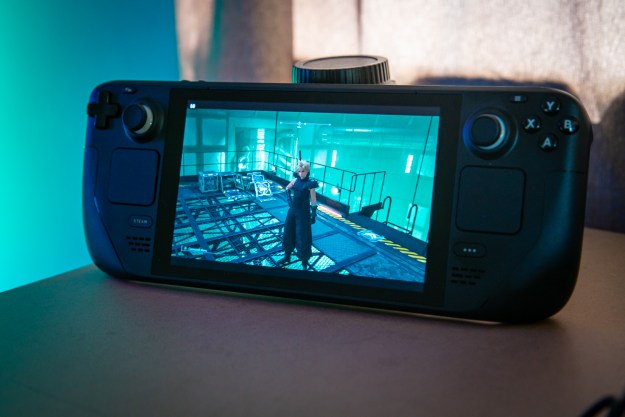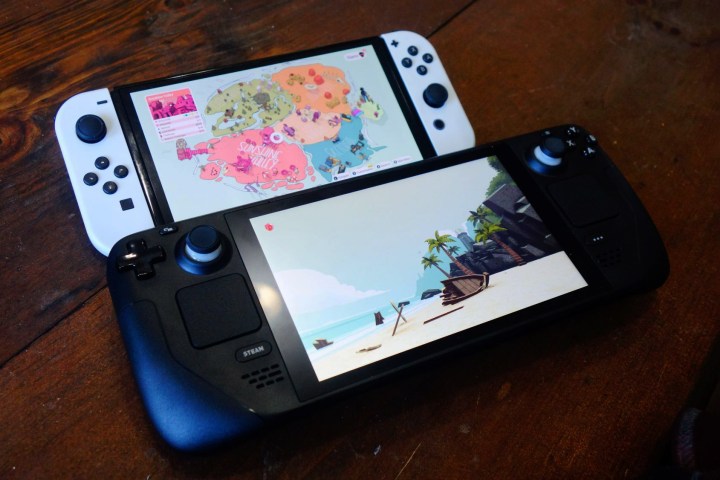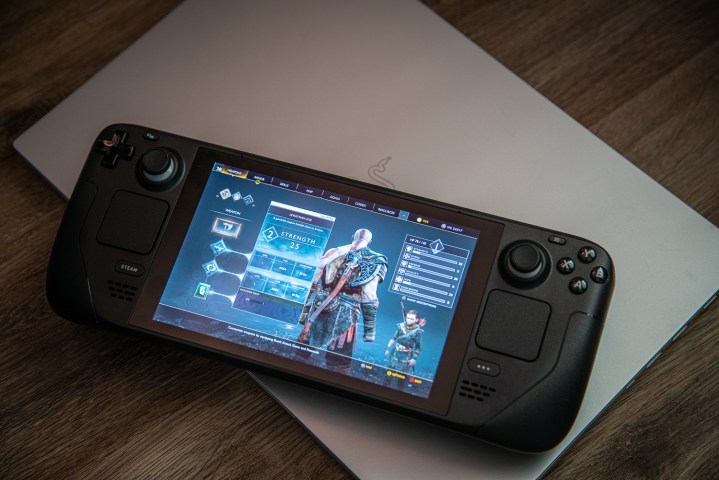
“The experimental Steam Deck is the king of portable gaming PCs thanks to Valve’s consistent software improvements.”
Pros
- Tons of control flexibility
- Excellent specs
- Fantastic speakers
- Clean Steam interface
- Constantly improving
Cons
- Awkward design
- Poor screen
- Finnicky Linux browser
Valve’s Steam Deck is an exercise in expectation setting. If you’re buying one hoping it’ll be the be-all and end-all of video game devices, you’re going to be disappointed. It’s not going to replace your PC or Nintendo Switch, nor does Valve intend for it to. And if you’re imagining a future where you’ll be able to download any new release and seamlessly take it on the go, keep dreaming.
While it’s undoubtedly an impressive portable gaming device, it’s important to remember that the Steam Deck is very much an experimental one, too. It’s another attempt to give players unlimited freedom in a sea of competing ideas that range from gaming tablets to cloud services to conceptual home servers. Valve does what it does best here (no, not develop video games) to create a powerful piece of hardware, but the Steam Deck is an alternate vision of the future, not an inherently better one.
When the Steam Deck is functioning at peak performance, it’s a revelatory device that feels like it could completely disrupt the gaming hardware cycle as we know it. At the same time, it’s very apparent that this is a first draft that leaves plenty of room for improvement. Valve has proved its up to that challenge by fixing the system’s weak battery and inconsistent game compatibility over time, though its poor screen and awkward design have already been improved upon by copycats. The Steam Deck may be more of a spark than a full-blown revolution, but it’s still the device that’s firmly leading the charge.
Carry that weight
Before diving into all the impressive specs, it’s important to get something very basic out of the way: holding a Steam Deck is akin to lifting a cat by its armpits.
The first thing you’ll notice when you unbox the device is that it’s a giant. Let’s use the Nintendo Switch OLED for comparison. The Steam Deck is just over 2 inches longer than that device, coming in at 11.7 inches. It’s height is a bit more comparable at 4.6 inches, but those few extra inches are noticeable. I can comfortably pick up my Switch with one hand wrapped around its edges, but I have to go full-on claw machine mode to scoop up the Steam Deck in the same way.

Naturally, that means that the Steam Deck is heavier, too, but it’s not quite the workout you might expect when you first see it. Despite weighing in at 1.47 pounds (versus the Switch OLED’s 0.93 pounds), my immediate thought upon picking it up wasn’t “oh no.”
What makes it a little awkward to hold, though, is how it sits in your hands. Since all of its buttons are pushed to the very top of the device, that means there’s a lot of console unsupported by your grip. That’s where my cat analogy comes in. The bottom half of the device ends up dangling when I play, like dead tummy weight. With the Switch, the bottom corners of the device end up resting in my palms, making it easy to hold up for long periods of time. With the Steam Deck, I often found myself resting it on my knees or a desk just to take some strain off myself.
I got used to it eventually, but I wouldn’t go as far as to use the word comfortable.
Granted, there are a few notable comfort considerations here. The rounded grips on each side are a natural fit in my hands, which is certainly a difference from the Switch’s pancake design. Even so, it’s a device you’re going to need to learn to work with. I got used to it eventually, but I wouldn’t go as far as to use the word comfortable.
Bells and whistles
When it comes to controls, the Steam Deck packs a lot of options in. It has a standard ABXY control setup with a trigger and bumper on each side, a pair of start/menu buttons, a D-pad, and two sticks. That’s a fairly basic setup, though button placement and size presents some challenges. It’s not just that everything is pushed up to the very top of the device; it’s that it can be hard to actually reach buttons.

The bumpers are the worst offenders. If I’m playing a game that requires me to press both a bumper and trigger routinely, I’m suddenly doing a juggling act as I shift my grip on the controller. In my most comfortable resting position, I can’t reach the bumpers without changing my grip to something that feels less stable. The tiny menu buttons also feel a bit out of reach at the very top, and it doesn’t help that I have to wedge my thumbs behind the sticks to get to them.
Luckily, the Steam Deck does have a great answer to those issues: four mappable back buttons. It’s an impressive addition that allows me to toss the triggers and key D-pad functions onto buttons that are much easier to access, which is a necessity in games like Elden Ring. The only annoyance there is that there’s no systemwide mapping option. It has to be done on an individual game basis every time, which is a hassle considering I just want to use it for bumpers consistently.

While there are quirks with the basic controls, it’s the extras that really make the Steam Deck stand out. Each side has a trackpad, which I’ve found surprisingly useful as a mouse replacement. The device supports gyroscopic controls, and while I don’t know how many games will use them, they worked perfectly well in Aperture Desk Job.
Though what I appreciate most of all is that it supports touch controls. When I loaded up Dicey Dungeons and realized I could tap on my map and throw my dice without touching a button, I realized that there are some PC games I’m going to play on this device exclusively from now on.
The beast incarnate
While it’s awkward on the outside, it quite literally is the inside that counts here. The Steam Deck is a true powerhouse for what it is, which is what makes it so exciting in spite of its quirks. That’s thanks to its RDNA 2 GPU and AMD Zen 2 CPU, the same tech that’s used in the PlayStation 5 and Xbox Series X. It’s not as powerful as those consoles, with the cutdown chip performing closer to the power of a PS4, but it’s impressive all the same.

When I booted up Nier: Automata and expected it to struggle, I was stunned to find that it ran as smooth as butter. I blindly started downloading random games from my library just to see what would happen and was routinely impressed with everything from indies to the AAA level. Shadow of the Tomb Raider hit a 52 frames per second (fps) average in its benchmark test. Even Elden Ring managed to work well enough. Sure, its frame rate fluctuated between 30 and 45, but I could get on an airplane tomorrow and play a brand new game that’s available on today’s most powerful consoles with little friction.
That’s the power of the Steam Deck in action. While the Nintendo Switch’s wow factor has worn off in recent years as its hardware ages, it’s incredible that I can take much bigger games on the go with the Steam Deck. And that doesn’t require a wireless connection like a cloud gaming service would, either. I played Red Dead Redemption 2 underground on the subway. If you had told me that would be possible even two years ago, I would have laughed in your face.
The Steam Deck is a true powerhouse for what it is, which is what makes it so exciting in spite of its quirks.
I’m perhaps most surprised by how fantastic the Steam Deck’s speakers are. Usually, onboard speakers on devices like this are obligatory, but weak. That’s not the case here. When I loaded up Hellblade: Senua’s Sacrifice, one of the best games I tried on it, I was shocked to hear its binaural audio effect come through perfectly. I could clearly hear voices whispering from each side of the device as if I had on a great pair of headphones. It’s one of many moments that genuinely blew me away during testing.
The 60 Hz LCD screen gets the job done, but it’s becoming more outdated as each new device that’s like it gets released. It pales in comparison to the screens on Lenovo’s Legion Go or even the Ayaneo 2S. It does fare pretty well in bright sunlight, which is a necessity for portability potential.

The tech rabbit hole goes even deeper. Users can set its GPU to a fixed clock, enable FSR scaling, enable a full performance overview on any game, and so much more. Options like that are what make the Steam Deck stand out over something like a Switch. It brings the nitty-gritty customization of a PC to a gaming handheld, which nothing else on the market can really match right now — especially at such a low price point.
Evolving game support
When the Steam Deck first launched, software compatibility was an absolute gamble. Valve uses a verification system that tells you which games that you own will most assuredly work on the Steam Deck without tweaks. When I first turned on the device at launch, I had around 180 games in my library. About 35 of them were in the verified tab.
That doesn’t mean every other game won’t work. On the contrary, many just haven’t been tested by Valve yet and work without a hitch. Steam has a “playable” marker too, denoting that a game will work with some quirks. For the aforementioned Dicey Dungeons, all that meant was that the mouse showed up on-screen. Otherwise, it’s a perfect experience.
Your experience with it is going to entirely depend on your Steam library.
With a lot of time on the market and plenty of interest from fans, playability has become much more consistent with each passing month. Largely gone are the days where Nier: Automata would automatically skip all of its dialogue. Major studios like FromSoftware have shown a strong commitment to Valve’s device, giving us more big-budget games that are compatible with the device on day one. It’s a strong improvement, though it’s still not 100% perfect. I still load up an indie every once in a while to find it simply won’t run. Granted, many developers seem to be optimizing for the device much quicker now that its a heavily adopted device.

Valve has also done a lot to solve the Steam Deck’s biggest issue: its initially. weak battery life. In its first month, Elden Ring drained the battery so fast that I went from a 10% battery warning to dead in minutes (I didn’t even have time to plug it in before it went black). It was kind of a deal breaker at the time for the device’s potential as a portable. One work commute would drain it. Valve has optimized that problem through software updates and that’s gone an incredibly long way. Nowadays, my play sessions with the Steam Deck are far longer. Big-budget games can still be a drain, but I have no problem running smaller titles on train rides without charging in-between. It’s been remarkable to watch the system grow and it speaks to Valve’s power as a hardware maker.
It’s worth noting that this isn’t like a PC insofar as you won’t be able to upgrade its parts down the line. What you’re getting here is what you’ll be locked to until Valve makes a new one. Battery and software optimization has really helped extend its life, but the device does struggle to keep up with PS5 and Xbox Series X games. If you’re choosing a portable PC for the first time, there are plenty of options like the Asus ROG Ally right now that heave Valve beat on power and performance.
Just as it was at launch, expectation setting remains crucial when grabbing a Steam Deck. You have to go into this expecting that some of your favorite games aren’t going to work well on it. Valve may say that you can take your entire Steam library on the go, but that’s not going to be the case. Even with that in mind, it’s absolutely thrilling when games do fully function, even if they’re smaller titles that could run on a Switch. I was able to buy Vampire Survivors on the device itself and take it on the subway before it was out on mobile devices. That experience still makes the Steam Deck feel revolutionary when it works at its best.
Work in progress
If it’s not already clear by now, the Steam Deck is a work in progress. That experiment has gone well so far, but it’s still evident that the work is ongoing in some of the device’s UI. On the positive side, the default Steam interface is better than the standard view available on PC. It’s much easier to browse your library, the store, friends list, and download progress. The console’s Steam button streamlines all of it in ways I wish I had on desktop. On the other hand, I’m still routinely bumping into software bugs that drive me up a wall. It feels like I bump into never-before-seen problems every other session, which range from the volume bar stopping at the halfway point to full bricking scares.
Then there’s the system’s complicated Linux browser. Theoretically, it’s a powerful tool that could let you download games beyond your Steam library, including emulators. It’s not easy to use currently, though. Part of that is just because Linux can seem alien if you’ve been raised on Windows, but there are some quirks beyond that (and note that Windows devices like the ROG Ally have since shown us that the OS comes with its own annoyances).
The Steam Deck ultimately reminds me of putting on an early VR headset in the mid-2010s.
When I click on a text box, the keyboard doesn’t always populate on -reen. I’m supposed to be able to bring it up at any time by pressing the Steam button and X at the same time, but it doesn’t always work. I would also routinely try to exit back to the standard Steam view, only for Linux to tell me an app that wasn’t open was blocking it. I had to power down the device on a few occasions because I just couldn’t figure out how to get out otherwise. If you want to play with it, bring a mouse and keyboard.
Some of that will surely be fixed over time, though I think an upgraded model could do a lot more to make the device easier to use. The OneXPlayer Mini, for instance, includes a button that automatically calls the Windows keyboard up at any time. It also includes a USB-A port and two USB-C ports, which make it easy to plug any device in, whereas Steam Deck only has a USB-C port that’s used for charging (though it’s Bluetooth-ready, which mitigates the lack of wired options).

The Steam Deck ultimately reminds me of putting on an early VR headset in the mid-2010s. I remember throwing on a gigantic Vive around 2014 and being incredibly impressed by the experience. But I also walked out knowing that the tech would evolve fast, making me skeptical about investing at the time. Anyone who waited for the much cleaner Meta Quest 2 didn’t really miss much.
The Steam Deck has already proven to be a similar kind of experience. It was a revelatory game-changer for early adopters, but those who waited got some more powerful competitors like the Asus ROG Ally. The later you buy a device like this, whether it’s this version of the Steam Deck or a copycat, the better it’s going to be. All that said, Valve has proven that it isn’t abandoning the device anytime soon like some of its older experiments. Every change has gone a long way toward improving the system, so much so that its still my portable handheld of choice over ones that are definitively better on paper.
There’s a lot I could criticize the Steam Deck for. It has an awkward design, a weak screen, unpredictable bugs, a quirky Linux browser, and much more. Even with all those issues, I still find myself thrilled that it exists. This is a powerful gaming device that’s simply unmatched thanks to its clean SteamOS experience. The fact that it can run Elden Ring, a AAA release that couldn’t run on my PC, speaks to its overall value as a portable device. When I initially reviewed the system I said that Valve has a lot of tweaking to do if it wants this to have an audience beyond the techie crowd. It has accomplished exactly that, and that’s a feat worth applauding.


